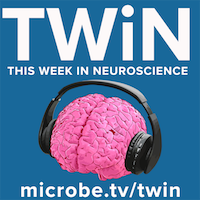TWiN discusses research showing that sciatic nerve activation with electroacupuncture at the sciatic nerve controls systemic inflammation and rescues mice from polymicrobial peritonitis, by inducing vagal activation of aromatic L-amino acid decarboxylase, leading to the production of dopamine in the adrenal medulla.
TWiN reviews a mouse model of ADHD to characterize hypersensitivity to pain, and that sensitization is further amplified in a pathological inflammatory state.
TWiN discusses a study of on the pathways that control opioid analgesic tolerance, a root cause of opioid overdose and misuse, which can develop through an associative learning.
Vivianne explains how early in Alzheimer’s disease, the brain attempts to counteract the increased excitatory drive caused by amyloid deposition, and that melanin-concentrating hormone, produced during sleep, is involved in this protective response.
TWiN answers listener questions about Alzheimer’s disease, glaucoma and the microbiota, Dravet’s Syndrome, schizophrenia, brain development, and chips implanted in the human brain.
Jason and Tim review the use of an implanted chronic deep brain sensing and stimulation device to carry out biomarker-driven closed-loop therapy that resulted in a rapid and sustained improvement in depression.
Michael Nitabach joins TWiN to discuss the finding that the nematode C. elegans, which do not have eyes, can discriminate between colors to guide foraging decisions and move them away from harmful bacteria that produce a blue-pigment toxin.
Stefano joins TWiN to discuss his work on understanding genomic decoding of neuronal depolarization by stimulus-specific transcriptional regulators.
The TWiN team reveals how the nervous system controls hair graying in mice subjected to stress, and adaptive immune responses.
Bob Datta joins TWiN to reveal the findings of his laboratory on expression of SARS-CoV-2 entry genes in the olfactory epithelium and the implications for anosmia associated with COVID-19.

